If you already have a Red Tail shark or wish to add one of these sharks to your aquarium, you are at the right place. I know you must be wondering: what is this stunning creature? What does Red-Tailed shark eat? What maintains its vibrant colors? That’s where I come in.
We know that understanding the needs of your Red Tail pet can be puzzling. In this guide, we will discuss all you need to know about this vibrant creature. Moreover, we will talk about its looks and natural habitat. In the end, we will explore a detailed Care Guide for Red-tailed sharks.
Here is a quick guide for taking care of your Red Tail shark
Quick Care Guide
| Minimum Tank Size | 55 gallons (the bigger the better) |
| Water PH | 6.5 to 7.5 |
| Water Temperature | 72°F – 79°F |
| Care Level | Moderate |
| Maximum Size | 8 inches |
| Tank Mates | Yes (ideally fast-moving and robust fishes) |
| Diet | Primarily carnivores (do eat veggies as well) |
For a more detailed Insight, read the article below.
Red Tail Sharks Origin
The Red-Tailed shark belongs to the “Cyprinidae” family. It calls the freshwaters Southeast Asia its home, specifically from Thailand. It originates from the rocky waters of the Chao Phraya River basins. Having a dark body coloration with a red tail makes it a unique creature.
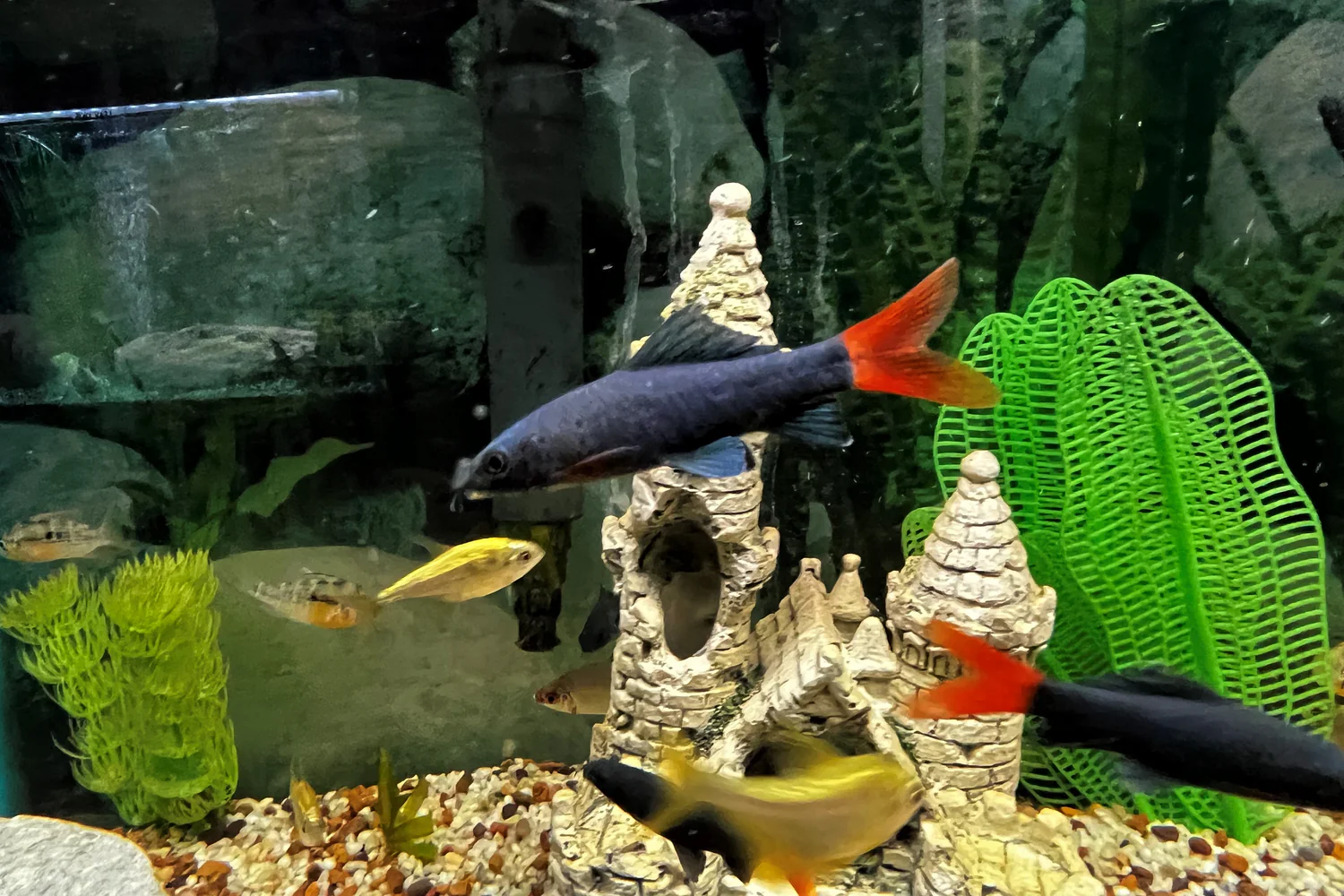
It is also known as the “Chinese Firetail”. Other common names include “Red Tail Black Shark” or “Red-tailed Labeo” Due to its distributed population, it is seen in different regions. Although the majority of this fish belongs to the Thailand region. A large population of this fish thrives in the “Bueng Boraphet” Lake in Thailand.
Red Tail Shark Life Span
Red-Tailed sharks have a long life span. In captivity, this fish can live up to a whopping 6 to 8 years when properly looked after. In the wild, its lifespan is about 4 to 6 years because of predation and habitat degradation.
Its lifespan in captivity depends on many factors like water quality, diet, tankmates, and tank size. To ensure that your fish has a long and happy life, follow the tips in this care guide.
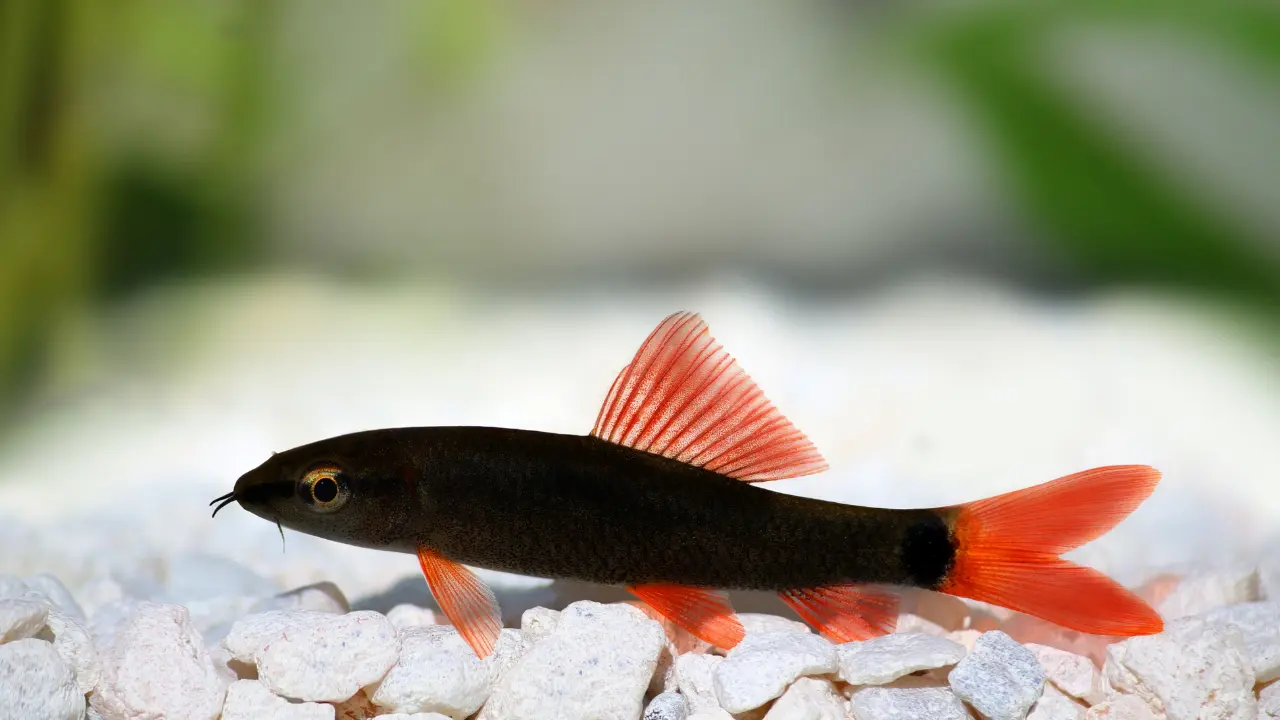
Red Tail Shark Size and Appearance
The Red-Tailed shark is well known for its intriguing appearance. It has a body size of about 6 inches in captivity and 8 inches in the wild. It has compressed and a deep build, just like a sleek oval plate. The black and red fishy has an elongated body with a rounded tail fin. This physique is not just for show, it allows the shark to make sharp and quick movements while catching prey. Keep in mind, that the Genes, tank size, water conditions, and food influence their growth so the size may vary from fish to fish.
Male and female Red-Tailed sharks have a variety of coloration. Males have shiny bodies with a black hue and a red tail. Their eyes are adorned with natural mascara and their bodies with vertical bars. The sharp and long fins enhance their agility and beauty even more.
In contrast, the females have subdued colors. They have olive green or brown bodies with less prominent markings. The fins are also smaller and less sharp as compared to the males.
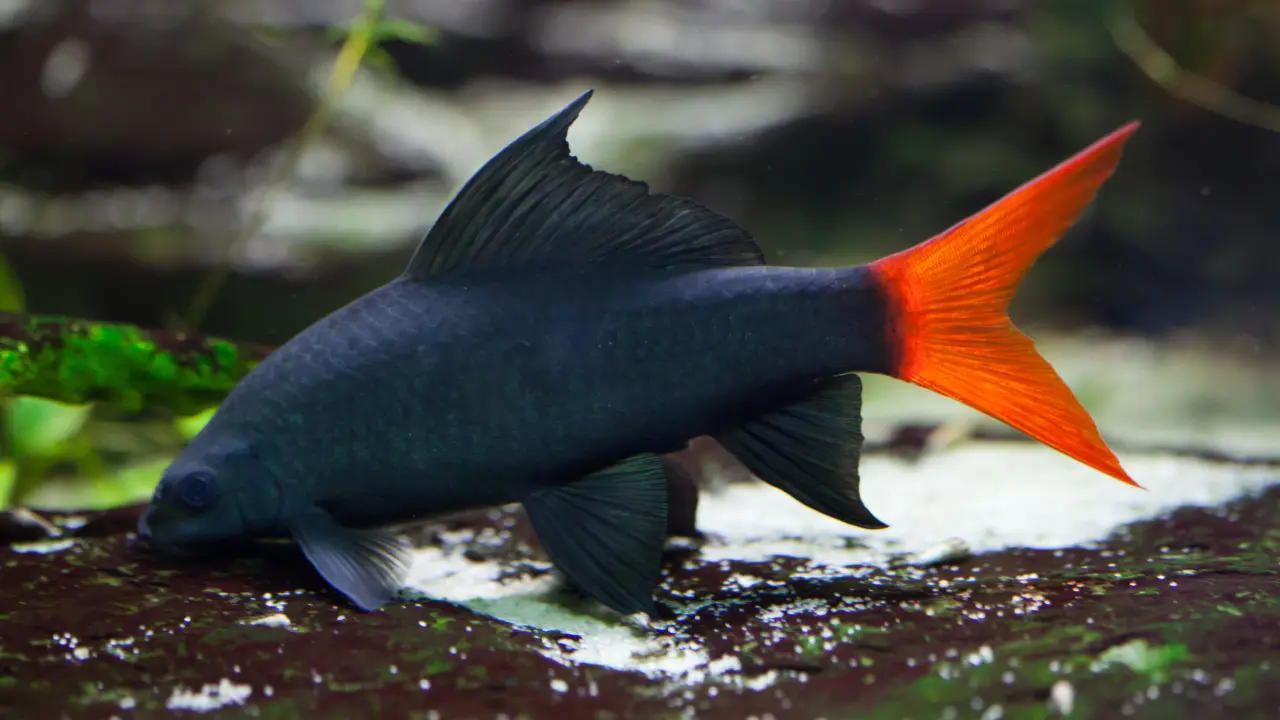
Interestingly, this fish can change its body color depending on its mood. When it is under stress, the body color might darken while the tail fin may become dull. Moreover, small black spots on the head indicate that it is trying to communicate with other fish.
Another notable adaptation is the protruding lower jaw, resembling a shovel. This shovel-like mouth is perfect for quick attacks and suction used to hunt prey. In addition to that, small pointy teeth make a perfect pair with the mouth to snatch prey with no chance of escape.
Red Tail Shark Natural Habitat
Freshwater rivers are the natural habitat of the Red Tailed Shark. These rivers and streams usually have slow to moderately fast water flow. Ideally, they like to live in waters with rocky substrates and a lot of plants. This gives them enough hiding spots to avoid predators and hunt for prey.

Red-tailed Labeo can adapt to various habitats and conditions. They can manage a wide range of pH and hardiness. However, they are very sensitive to water quality and oxygen levels and live in clean waters surrounded by greenery. This greenery helps in cleaning and filtering the water.
Red Tail Shark Care Guide
The Red-Tailed shark is an endangered species of fish. Having proper care is vital for its survival in captivity.
As this is an endangered fish, I would suggest only to get one if you can commit to it. Due to its status, domesticating one is a contribution to its conservation. However, if proper care is not provided, it could be quite the opposite.
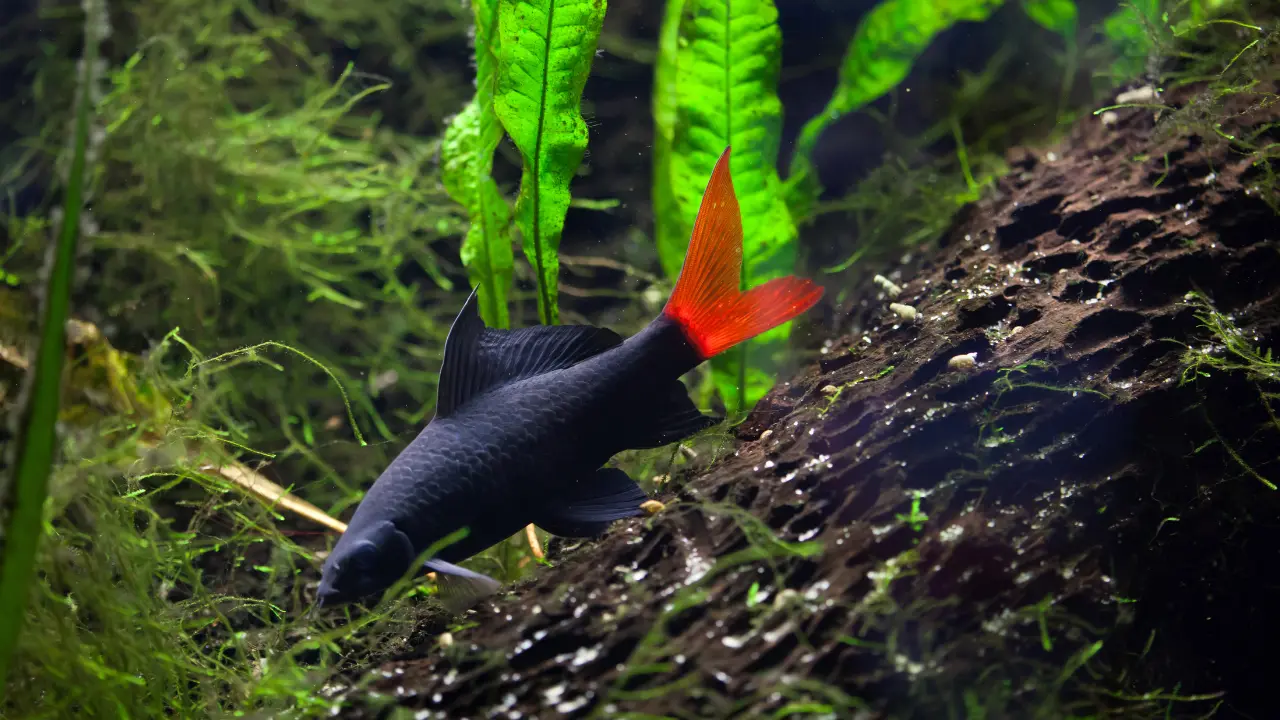
Here is our expert guide on How to take care of Red-Tailed Sharks in a Tank.
Tank Size
This is a very active fish and requires ample space to thrive. You should have a minimum tank size of about 55 gallons for 1 fish. If you plan to add more, consider the size of the new fish and increase space respectively.
The Red Taiedl shark is territorial. The tank should be big enough for everyone to have their own space. This will prevent overcrowding and maintain a healthier environment for all tankmates. It is best to add a lot of hiding spots, using driftwood and rocks to make small caves for the fish to play and hide.
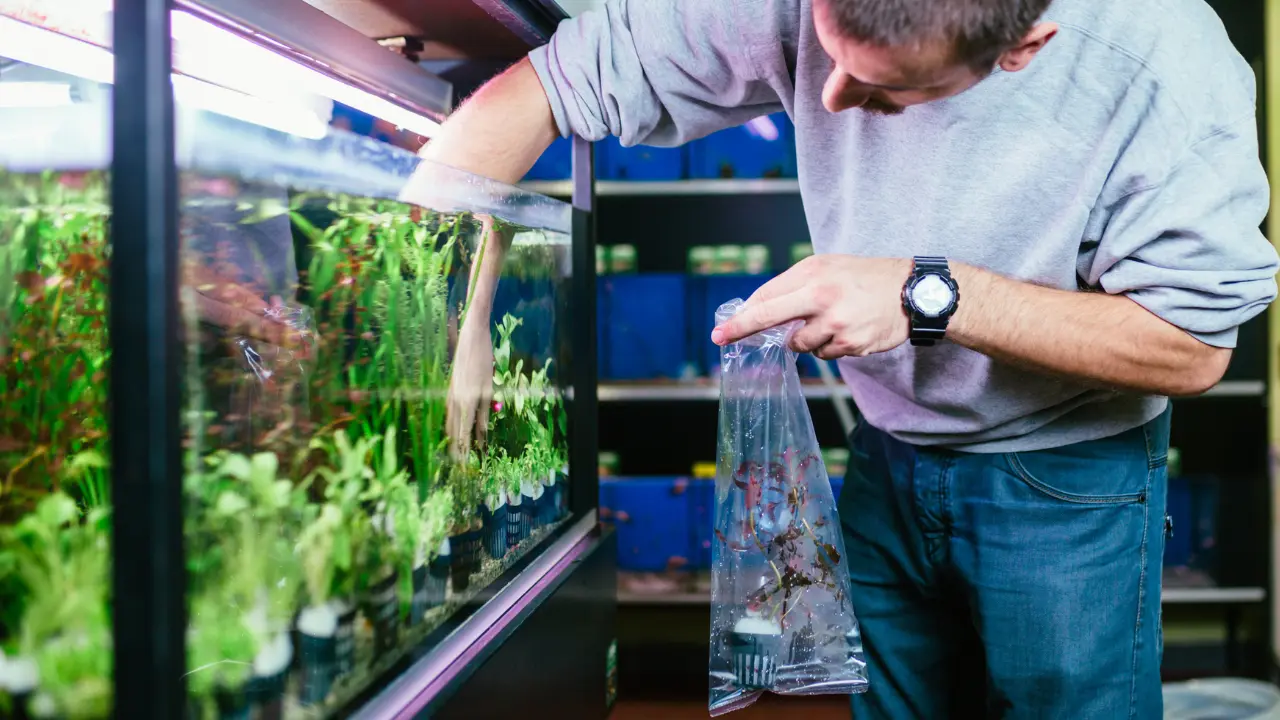
Water Parameters
A pH level between 6.5 and 7.5 is ideal for the Red Tail sharks as it replicates their natural environment. The ideal water temperature should be between 72°F and 79°F.
Fluctuations in temperature and pH can stress the fish. This will compromise their immunity which can lead to issues.
You should regularly monitor the water by using a water test kit is a good option. Moreover, you should maintain the oxygen and cleanliness levels of the tank. Investing in a good water filter is a small cost to pay for such an intriguing addition to your tank.
Tank Decor and Substrate
The Red Tail shark has a nocturnal nature. This means that it requires a lot of hiding spaces. Make a lot of sturdy structures that can survive its active and playful behavior. Always avoid sharp objects and gaps in the structures. It is ideal to have a balance between the swim space and the hiding area. The substrate should be moderately-sized gravel. Pebbles could make a nice addition.

Use driftwood and natural rocks to make these structures. You can also use artificial plants as a substitute for natural ones. Be a little careful! our little fishy tends to uproot and snatch at the natural plantations.
Red Tail Shark Diet
Wondering: what do Red Tail sharks eat? Mostly its diet includes a lot of protein. This fish prefers a carnivorous diet but it does like to munch on plants and vegetables as well.
To make sure that all required nutrition is provided, give the Sharkie a mixed meal. Mainly provide frozen or live invertebrates like brine shrimp and blood worms. Occasionally, add blanched or boiled vegetables as supplements. If you are looking for quick meals, then commercial sinking palettes and flakes could be a good choice.

keeping all that in mind, make sure you don’t overfeed or underfeed your fish. You shouldn’t feed it more than twice a day.
Deciding the right diet portions is vital to prevent water contamination and health issues.
Here are the best foods for Red-Tailed Shark
- Algae
- Plant-based Foods
- Animal-based Foods
- Bloodworms
- brine shrimp
- Sinking palettes
- Flake foods
- Fresh blanched Veggies
Here are some quick links for the Best Commercial foods for Red Tailed Sharks
- Aqueon Tropical Granules Fish Food
- Purify Series Small Tropical Sinking Pellets
- API Tropical Pellets
- Hikari Tropical Sinking Wafers
Red Tail Shark Behavior
Thinking, Is Red-Tailed shark aggressive? Yes! this fish has a temper and can get territorial. However, it all depends on the tank environment and tank mates. They often like to establish dominance in the tank. However, if there is enough space in the tank the sharkie can think about coexisting with the homies.
The Famous Firetail shark can get aggressive towards smaller-sized tank mates. It’s ideal to have similar-sized tankmates with no striking markings to avoid fights. Bottom-dwelling tank mates are also a big No!

Red Tail Shark Tank Mates
When choosing Red -Tailed shark tankmates compatibility is key. You should go with fish that can compromise with the territorial nature of the shark. Similar interactions are also important so the Red sharkie doesn’t feel left out. Go for quick-moving fishes that like to play along and have fun. I would recommend tank mates like barbs, danios, and loaches are suitable companions. You must avoid slow-moving fish with similar shapes to the Red-Tailed shark, or it could get quite messy.
Make sure that the tank mates don’t occupy all the hiding spots. Regularly, Monitor the tank and look out for potential fights. Lastly, Selecting the right tankmates can make a beautiful community tank. Take a look at our expert opinion!
- Tiger barbs
- Zebra danios
- Rosy barbs
- Clown loaches
- Bala sharks
- Rainbowfish
- Yoyo loaches
- Harlequin rasboras
Breeding
It could be quite challenging to breed the Red-Tailed sharks although it is rewarding. These fish lay eggs to reproduce, usually in a specific tank environment. During breeding the males are very active and display vibrant colors. The females on the other hand get the big ol’ mama belly.
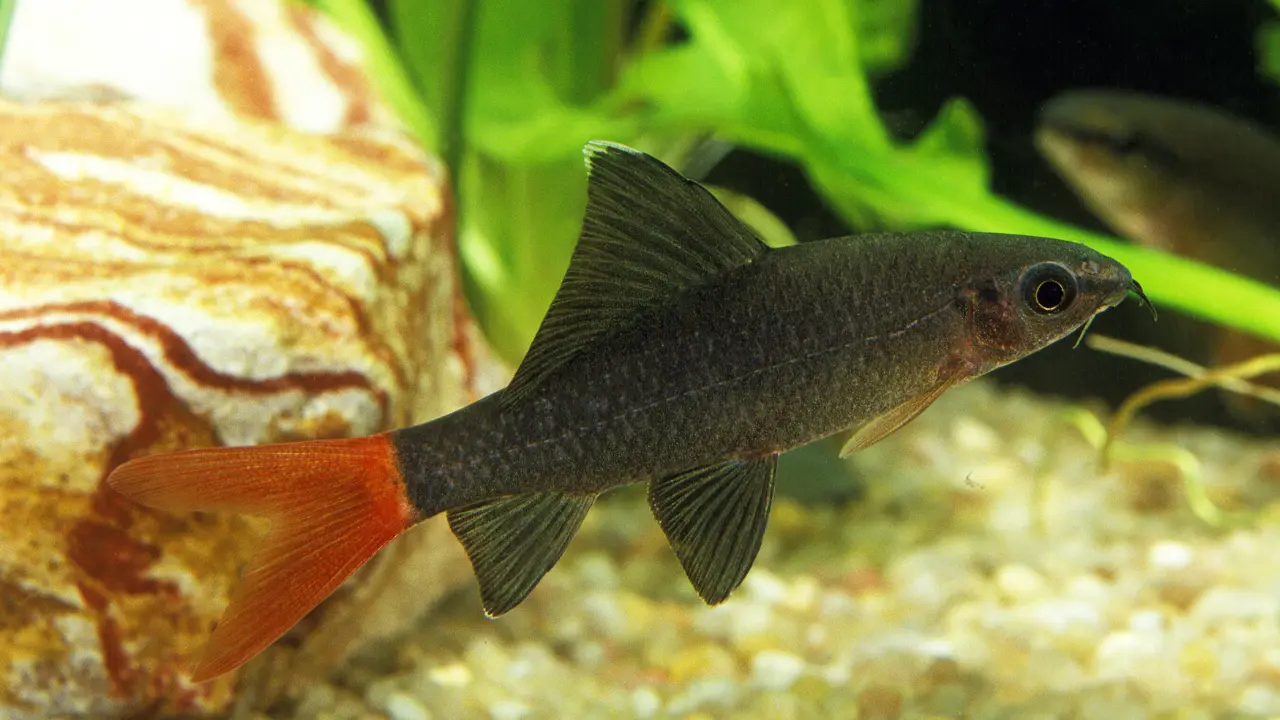
There isn’t much to the ideal breeding tank conditions. Slightly crank up the temperature and make the water a little acidic. This will increase the chances of successful breeding and do the job. Make sure they have some privacy! other fish should leave the tank and they should be alone. Jokes aside, the eggs are actually vulnerable in the presence of other fish.
Once spawning starts the female lays the eggs on surfaces like rocks and leaves. Then the male would fertilize the eggs and both parents would protect them. When the eggs hatch, you can feed them baby brine shrimp or commercial fry food. This will encourage the initial development.
FAQ’s
How big will a Red Tail shark get
They can grow up to 6 inches in captivity. Although the Red Fin shark size may vary from fish to fish as it depends on genes, Tank condition, and more.
What is the care level for a Red Tail shark?
As an endangered species, this fish needs moderate care level. You should commit to its care if you do get one.
Can I keep other species with my Red-Tailed Shark?
Yes, but choose the tank mates with extreme care. take a look at the about given article to get a guide.
Do Red Tail sharks eat other fish?
Yes! Red-Tailed sharks can get aggressive towards smaller fish and might eat them. Make sure you choose tank mates carefully.
how many Red Tail sharks can live together?
The number of Red-Tailed sharks that can live together depends upon a lot of factors like tank size, other tank mates, and much more. take all these factors into consideration.
Conclusion
In conclusion, now you know all about “What Do Red Tail Sharks Eat? A Comprehensive Guide to Diet Care & Behavior”. We have discussed the dietary requirements, the tank mates, the breeding, and much more. If you still have questions, shoot us a message or take a look at the above-given article.
knowing about your pet is important. We should know that a pet is a responsibility. Especially, domesticating an endangered species is a commitment. Discussing their preference and habitat is very important. Before you make a decision, Make sure of it!
